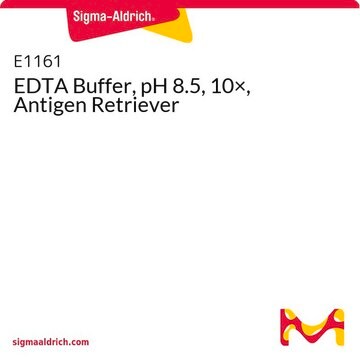C9999
Citrate Buffer, pH 6.0, 10×, Antigen Retriever
for immunohistochemistry
Synonym(s):
1,2,3-Propanetricarboxylic acid, 2-hydroxy-, mixt. with sodium hydroxide (Na(OH)) and sodium 2-hydroxy-1,2,3-propanetricarboxylate
Sign Into View Organizational & Contract Pricing
All Photos(1)
About This Item
UNSPSC Code:
12352107
NACRES:
NA.47
Recommended Products
Application
Citrate Buffer, pH 6.0, 10×, Antigen Retriever has been used as a heat-induced antigen retriever on formalin-fixed paraffin-embedded (FFPE) tissue sections prior to application of antibodies or DNA fluorescent in situ hybridization. In immunohistochemistry (IHC), most commonly used fixatives such as formalin mask tissue antigens (cellular, membrane, and nuclear) by their intrinsic crosslinking. This masking results in poor or no staining in IHC. The use of Citrate buffer, pH 6.0, or other antigen retrieval solutions on FFPE tissue sections improves accessibility of antibodies to tissue antigens.
Preparation Note
Dilute the Citrate buffer, pH 6.0, 10x, Antigen Retriever 10-fold with water to prepare a 1x Working Solution, e.g., dilute 10 mL of 10x concentrate with 90 mL of water.
Storage and Stability
Store the product at 2–8 °C. Do Not Freeze to prevent possible precipitation.
Other Notes
Occasionally the buffer may contain a yellowish tinge. This is due to preservative and will not affect the function of the buffer.
Store the prepared 1′ Citrate buffer, pH 6.0, Working Solution at 2–8 °C.
Store the prepared 1′ Citrate buffer, pH 6.0, Working Solution at 2–8 °C.
related product
Product No.
Description
Pricing
Signal Word
Warning
Hazard Statements
Precautionary Statements
Hazard Classifications
Aquatic Chronic 3 - Skin Sens. 1
Storage Class Code
12 - Non Combustible Liquids
WGK
WGK 2
Flash Point(F)
Not applicable
Flash Point(C)
Not applicable
Certificates of Analysis (COA)
Search for Certificates of Analysis (COA) by entering the products Lot/Batch Number. Lot and Batch Numbers can be found on a product’s label following the words ‘Lot’ or ‘Batch’.
Already Own This Product?
Find documentation for the products that you have recently purchased in the Document Library.
Customers Also Viewed
Hyun Jin Cho et al.
BMC infectious diseases, 20(1), 81-81 (2020-01-31)
Macrophages play a key role in the infection process, and alternatively activated macrophages (M2 polarization) play important roles in persistent infection via the immune escape of pathogens. This suggests that immune escape of pathogens from host immunity is an important
Talveen S Purba et al.
European journal of cell biology, 96(6), 632-641 (2017-04-18)
Human hair follicle (HF) growth and hair shaft formation require terminal differentiation-associated cell cycle arrest of highly proliferative matrix keratinocytes. However, the regulation of this complex event remains unknown. CIP/KIP family member proteins (p21CIP1, p27KIP1 and p57KIP2) regulate cell cycle
Sumit Agarwal et al.
Translational oncology, 13(7), 100776-100776 (2020-05-19)
Pancreatic ductal adenocarcinoma (PDAC) is an aggressive cancer with an extremely poor prognosis. There is an urgent need to identify new therapeutic targets and also understand the mechanism of PDAC progression that leads to aggressiveness of the disease. To find
Joel L Coble et al.
Human molecular genetics, 26(16), 3212-3220 (2017-06-09)
Diverticulitis is a chronic disease of the colon in which diverticuli, or outpouching through the colonic wall, become inflamed. Although recent observations suggest that genetic factors may play a significant role in diverticulitis, few genes have yet been implicated in
Jennifer A Francesconi et al.
Behavioural brain research, 382, 112467-112467 (2020-01-10)
Male and female C57BL/6 J mice were tested on the predator odor response task, where they needed to cross through a chamber of scented bedding to reach a sucrose reward. Following the behavioral testing, mouse brains were immunohistochemically labeled for expression
Our team of scientists has experience in all areas of research including Life Science, Material Science, Chemical Synthesis, Chromatography, Analytical and many others.
Contact Technical Service









